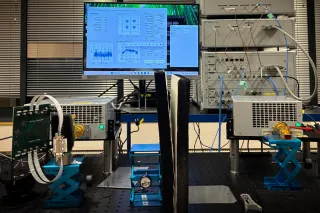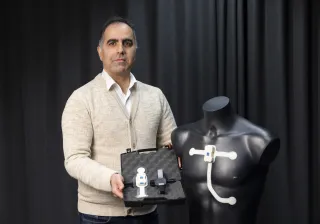Optical microcircuits enhance health, security and computation capacity
VTT Technical Research Centre of Finland, together with Tampere University of Technology (TUT), accelerates the development and commercialisation of silicon photonics products as part of the renewal of the Finnish electronics industry. With the help of silicon photonics, companies can develop increasingly compact, more efficient and more affordable products, where optical signals are used for such purposes as precise measuring, laser imaging and rapid data transfer.
"Soon we will be using silicon photonics in the same manner as we use electronic microcircuits that have been replacing discrete transistors and electron tubes since the 1960s," notes Timo Aalto, who leads the project.
"With the help of silicon photonics, we can replace modules built of separate components with photonic integrated circuits. They can be used for such applications as intelligent sensors identifying multiple gases, small silicon chips capable of medical imaging, navigation devices for autonomous systems, energy-efficient data transfer in date centres and optical quantum computing and encryption systems," Aalto explains.
The VTT-led RAPSI project, RAPSI standing for "Ramping up silicon photonics business in Finland", develops silicon photonics and its introduction into different applications. The aim is to generate additional revenues for the Finnish economy from silicon photonics amounting to more than EUR 15 million by 2020 and more than EUR 100 million by 2030. Photonics integration is a global trend where Finland has excellent chances of success on the worldwide markets.
The RAPSI co-innovation project, co-financed by Business Finland, consists of a public research project, which is carried out by VTT and Tampere University of Technology (TUT), and a number of industrial projects led by Finnish companies. VTT coordinates the development of an open silicon photonics technology platform. The benefits of this technology include low optical losses, dual-polarization operation, ultra-dense integration and low-cost volume manufacturing. TUT focuses on the development of compound semiconductor light sources and their integration on silicon chips.
As part of RAPSI, Rockley Photonics, Vaisala, Okmetic and VTT Memsfab have their own industrial projects. The RAPSI consortium also includes Beneq, TTM Technologies and Noptel. As part of the project, the companies develop new manufacturing methods for silicon photonics and their own silicon photonics products.
Clean rooms are the prerequisite of research and business within the field
Electronic and optical integrated circuits are developed and manufactured in clean room facilities. In Finland, silicon photonics R&D mostly takes place in the Micronova clean room facility that serves the needs of not only basic and applied research, but also commercial manufacturing. Silicon photonics has arisen as the technology driver of Micronova's business, but the same clean room facilities in Espoo are also used by multiple other technologies and several Finnish companies. Therefore, also Micronova plays a key role in the renewal of the Finnish electronics industry.






